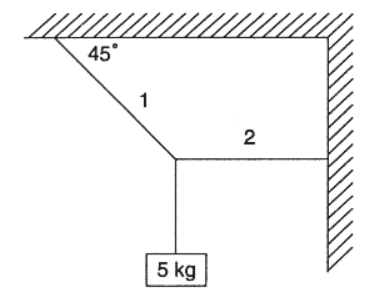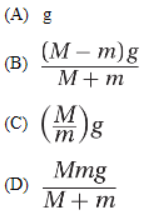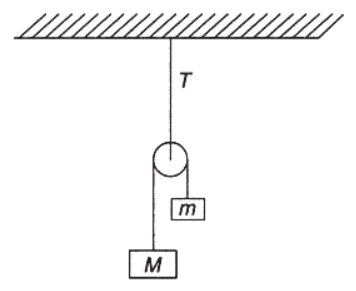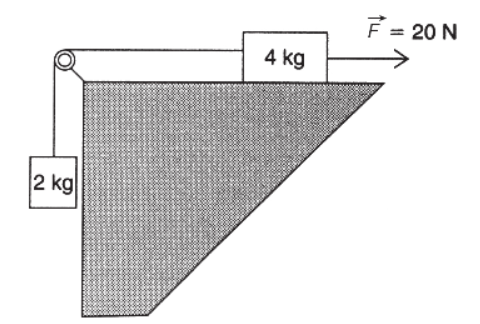Practice Exercises - Forces and Newton's Laws of Motion - AP Physics 1 Premium 2024
Multiple-Choice
1. In the situation shown below, what is the tension in string 1?
(A) 69.3 N
(B) 98 N
(C) 138.6 N
(D) 147.6 N

2. Two masses, M and m, are hung over a massless, frictionless pulley as shown below. If M > m, what is the downward acceleration of mass M?


3. A 0.25-kg mass is attached to a string and swung in a vertical circle whose radius is 0.75 m. At the bottom of the circle, the mass is observed to have a speed of 10 m/s. What is the magnitude of the tension in the string at that point?
(A) 2.45 N
(B) 5.78 N
(C) 22.6 N
(D) 35.7 N
4. A car and driver have a combined mass of 1,000 kg. The car passes over the top of a hill that has a radius of curvature equal to 10 m. The speed of the car at that instant is 5 m/s. What is the force of the hill on the car as it passes over the top?
(A) 7,300 N up
(B) 7,300 N down
(C) 12,300 N up
(D) 12,300 N down
5. A hockey puck with a mass of 0.3 kg is sliding along ice that can be considered frictionless. The puck’s velocity is 20 m/s. The puck now crosses over onto a floor that has a coefficient of kinetic friction equal to 0.35. How far will the puck travel across the floor before it stops?
(A) 3 m
(B) 87 m
(C) 48 m
(D) 58 m
6. A spring with a stiffness constant k = 50 N/m has a natural length of 0.45 m. It is attached to the top of an incline that makes a 30° angle with the horizontal. The incline is 2.4 m long. A mass of 2 kg is attached to the spring, causing it to be stretched down the incline. How far down the incline does the end of the spring rest?
(A) 0.196 m
(B) 0.45 m
(C) 0.646 m
(D) 0.835 m
7. A 20-N force is pushing two blocks horizontally along a frictionless floor as shown below.

What is the force that the 8-kg mass exerts on the 2-kg mass?
(A) 4 N
(B) 8 N
(C) 16 N
(D) 20 N
8. A force of 20 N acts horizontally on a mass of 10 kg being pushed along a frictionless incline that makes a 30° angle with the horizontal, as shown below.

The magnitude of the acceleration of the mass up the incline is equal to
(A) 1.9 m/s2
(B) 2.2 m/s2
(C) 3.17 m/s2
(D) 3.87 m/s2
9. According to the diagram below, what is the tension in the connecting string if the table is frictionless?

(A) 6.4 N
(B) 13 N
(C) 19.7 N
(D) 25 N
10. A mass, M, is released from rest on an incline that makes a 42° angle with the horizontal. In 3 s, the mass is observed to have gone a distance of 3 m. What is the coefficient of kinetic friction between the mass and the surface of the incline?
(A) 0.8
(B) 0.7
(C) 0.6
(D) 0.5
Free-Response
1. A 3-kg block is placed on top of a 7-kg block as shown below.

The coefficient of kinetic friction between the 7-kg block and the surface is 0.35. A horizontal force F acts on the 7-kg block.
(a) Draw a free-body diagram for each block.
(b) Calculate the magnitude of the applied force F necessary to maintain an acceleration of 5 m/s2.
(c) Find the minimum coefficient of static friction necessary to prevent the 3-kg block from slipping.
2. A curved road is banked at an angle θ, such that friction is not necessary for a car to stay on the road. A 2,500-kg car is traveling at a speed of 25 m/s, and the road has a radius of curvature equal to 40 m.
(a) Draw a free-body diagram for the situation described above.
(b) Find angle θ.
(c) Calculate the magnitude of the force that the road exerts on the car.
3. The “rotor” is an amusement park ride that can be modeled as a rotating cylinder, with radius r. A person inside the rotor is held motionless against the sides of the ride as it rotates with a certain velocity. The coefficient of static friction between a person and the sides is µ.
(a) Derive a formula for the period of rotation T, in terms of r, g, and µ.
(b) If r = 5 m and µ = 0.5, calculate the value of the period T in seconds.
(c) Using the answer to part (b), calculate the angular velocity ω in radians per second.
4. How does the rotation of Earth affect the apparent weight of a 1-kg mass at the equator?
5. If forces occur in action-reaction pairs that are equal and opposite, how is it possible for any one force to cause an object to move?




